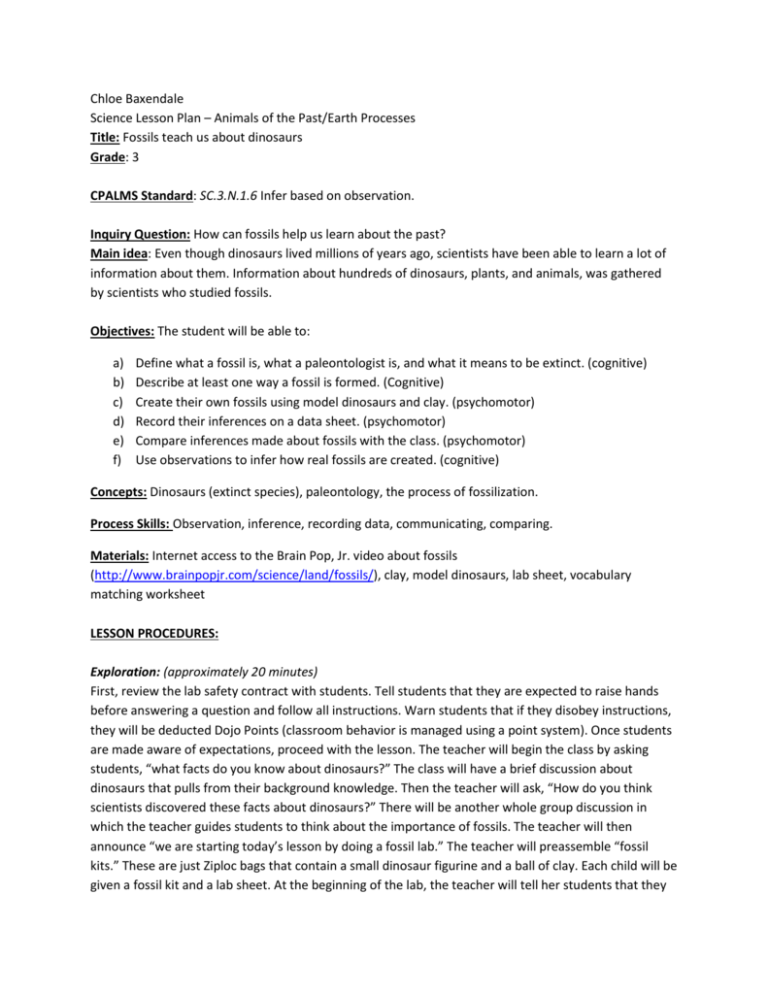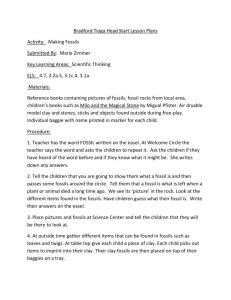File - Chloe Baxendale`s Teaching Portfolio
advertisement

Chloe Baxendale Science Lesson Plan – Animals of the Past/Earth Processes Title: Fossils teach us about dinosaurs Grade: 3 CPALMS Standard: SC.3.N.1.6 Infer based on observation. Inquiry Question: How can fossils help us learn about the past? Main idea: Even though dinosaurs lived millions of years ago, scientists have been able to learn a lot of information about them. Information about hundreds of dinosaurs, plants, and animals, was gathered by scientists who studied fossils. Objectives: The student will be able to: a) b) c) d) e) f) Define what a fossil is, what a paleontologist is, and what it means to be extinct. (cognitive) Describe at least one way a fossil is formed. (Cognitive) Create their own fossils using model dinosaurs and clay. (psychomotor) Record their inferences on a data sheet. (psychomotor) Compare inferences made about fossils with the class. (psychomotor) Use observations to infer how real fossils are created. (cognitive) Concepts: Dinosaurs (extinct species), paleontology, the process of fossilization. Process Skills: Observation, inference, recording data, communicating, comparing. Materials: Internet access to the Brain Pop, Jr. video about fossils (http://www.brainpopjr.com/science/land/fossils/), clay, model dinosaurs, lab sheet, vocabulary matching worksheet LESSON PROCEDURES: Exploration: (approximately 20 minutes) First, review the lab safety contract with students. Tell students that they are expected to raise hands before answering a question and follow all instructions. Warn students that if they disobey instructions, they will be deducted Dojo Points (classroom behavior is managed using a point system). Once students are made aware of expectations, proceed with the lesson. The teacher will begin the class by asking students, “what facts do you know about dinosaurs?” The class will have a brief discussion about dinosaurs that pulls from their background knowledge. Then the teacher will ask, “How do you think scientists discovered these facts about dinosaurs?” There will be another whole group discussion in which the teacher guides students to think about the importance of fossils. The teacher will then announce “we are starting today’s lesson by doing a fossil lab.” The teacher will preassemble “fossil kits.” These are just Ziploc bags that contain a small dinosaur figurine and a ball of clay. Each child will be given a fossil kit and a lab sheet. At the beginning of the lab, the teacher will tell her students that they will be creating fossils. She will say to the students, “Use your clay and your dinosaurs to make fossils in whichever way you believe is appropriate. Then, on your lab sheet, describe the different ways you used your materials to make a fossil. After creating your fossil, also make an inference about how real fossils are formed and record it on your lab sheet.” Explanation: (approximately 25 minutes) The teacher asks the class to reflect on the activity they have just completed. Ask students how they utilized their materials in order to create fossils of their own. Write some student examples on the board. Then ask students, “based on your physical experience today, how do you think real fossils are formed?” Have a class discussion about how fossils take a long period of time to form and how a significant amount of pressure is often required to make them. Pull up the BrainPop video about fossils. Pass out the vocabulary matching worksheet. Inform students that they may complete the worksheet while the video is playing. Also ask the students to write down at least three interesting facts presented in the video on the back of their worksheet. Throughout the video, pause and ask the class important questions in order to encourage critical thinking. These questions should include: What are fossils? How do fossils form? In today’s lab, which material played the role of sediment and which material provided gravity and pressure? What other discoveries help us learn about the Earth’s past? Since videos can discuss topics at a quick pace, it is important to pause and present these questions so that a whole-group discussion may take place. It will reinforce facts that were just presented to students in the video. When the video concludes, the teacher will ask her students the inquiry question: How can fossils help us learn about the past? The teacher explains to her class that fossils give us clues about the past. By looking at fossils, we are able to learn about the lives of extinct creatures like dinosaurs. We can find fossilized items such as bones, teeth, and plants. These help us learn about what different dinosaurs ate and if they hunted other creatures. Fossils can also be traces left over from a dinosaur’s life. We have found dinosaur footprints, dinosaur nests, and even dinosaur droppings. This gives scientists more information about what dinosaurs ate, how they interacted with other dinosaurs, if they walked on two or four legs, and if they were migratory. Terms: Fossil: Something left from a plant or animal that lived long ago that has turned into rock. Extinct: No longer living and none of its kind are alive today. Sediment: Different kinds of rock or soil, like mud, sand, or clay. Paleontologist: A scientist who studies fossils to learn about the Earth’s past. Decompose: To break down or rot. Expansion: (approximately 10 minutes) The teacher will present the class with photos of actual dinosaur fossils. Based on the photos, students will be asked to identify “clues” that may show them how their dinosaur lived. For example, they may look at the tooth shape to see if it would be better for eating meat and plants. They will also look at the size to see if they believe it to be a predator or a form of prey to other dinosaurs. Students will take turns presenting their findings to the class. The teacher will elaborate on student findings to clarify how specific dinosaurs actually lived when they walked the Earth. Evaluation: (occurring informally during the Explanation portion of the lesson/through vocabulary worksheet) 1. Define what a fossil is, what a paleontologist is, and what it means to be extinct (Obj. a). 2. Describe at least one way a fossil is formed. (Obj. b). The following items are steps taken during the experiment and at the beginning of the Explanation portion of the lesson: Step 1: Create their own fossils using model dinosaurs and clay. (Obj. c) Step 2: Use observations to infer how real fossils are created. (Obj. f) Step 3: Record their inferences on a data sheet. (Obj. d) Step 4: Compare inferences made about fossils with the class. (Obj. e)





